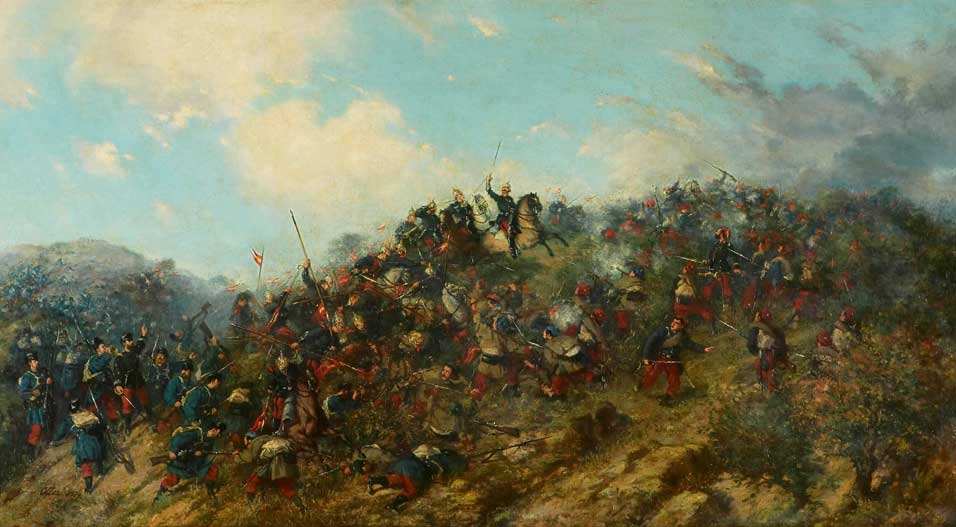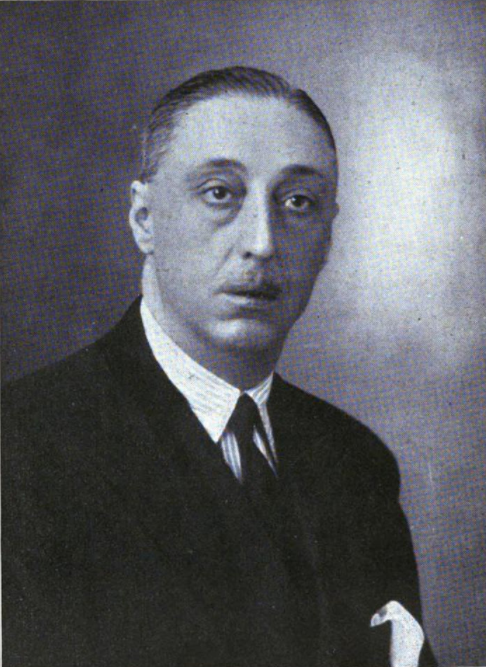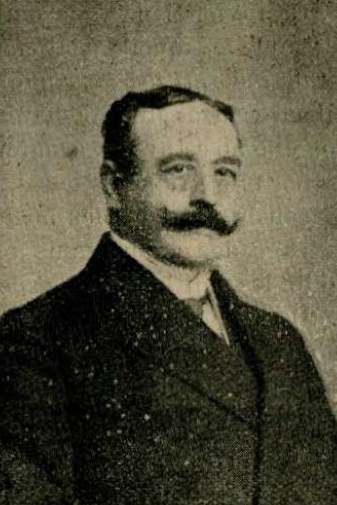|
Tomás Domínguez Romera
Tomás Domínguez Romera Pérez de Pomar, 11th Marquess of San Martín, Count consort of Rodezno, Count consort of Valdellano (1848–1931) was a Spanish aristocrat, landholder and politician. He supported the Carlist cause. His political climax fell on the years of 1905–1916, when during 4 consecutive terms he represented the district of Aoiz in the Congress of Deputies, the lower chamber of the Cortes. In the 1910s he held the Carlist regional jefatura first in New Castile and Extremadura, and then briefly in Andalusia; at that time he was also member of the nationwide party executive. Family and youth Tomás was descendant to a few well-off Andalusian landholder families. The Domínguez and the Trigueros have long been noted as distinguished figures in the city of Carmona ( Seville province); one representative of the Domínguez branch was regidor of the municipality in the late 18th century. Apart from large rural estates, the Domínguez family owned also a large h ... [...More Info...] [...Related Items...] OR: [Wikipedia] [Google] [Baidu] |
Carmona, Spain
Carmona is a town of southwestern Spain, in the province of Seville; it lies 33 km north-east of Seville. Carmona is built on a ridge overlooking the central plain of Andalusia; to the north is the Sierra Morena, with the peak of San Cristobal to the south. The city is known for its thriving trade in wine, olive oil, grain and cattle, and holds an annual fair in April. It is ascribed both to the comarca of Campiña de Carmona and the comarca of Los Alcores. Geography Location Carmona is located in the southwest of the Iberian Peninsula. It lies at about 249 metres above sea level, on a NE–SO ridge at the northeastern end of Los Alcores tableland, dominating over the meadows of the river, a left-bank tributary of the Guadalquivir. Climate Carmona has a Mediterranean climate with a sunny spring and typically some rain in that season. In October, the average temperature ranges from a minimum of 13 °C to a maximum of 26 °C. The city experiences a moderate ... [...More Info...] [...Related Items...] OR: [Wikipedia] [Google] [Baidu] |
La Rioja
La Rioja () is an autonomous community and province in Spain, in the north of the Iberian Peninsula. Its capital is Logroño. Other cities and towns in the province include Calahorra, Arnedo, Alfaro, Haro, Santo Domingo de la Calzada, and Nájera. It has an estimated population of 315,675 inhabitants (INE 2018), making it the least populated autonomous community of Spain. It covers part of the Ebro valley towards its north and the Iberian Range in the south. The community is a single province, so there is no County Council, and it is organized into 174 municipalities. It borders the Basque Country (province of Álava) to the north, Navarre to the northeast, Aragón to the southeast (province of Zaragoza), and Castilla y León to the west and south (provinces of Burgos and Soria). The area was once occupied by pre-Roman Berones, Pellendones and Vascones. After partial recapture from the Muslims in the early tenth century, the region became part of the Kingdom of Pamplona, lat ... [...More Info...] [...Related Items...] OR: [Wikipedia] [Google] [Baidu] |
Isabella II Of Spain
Isabella II ( es, Isabel II; 10 October 1830 – 9 April 1904), was Queen of Spain from 29 September 1833 until 30 September 1868. Shortly before her birth, the King Ferdinand VII of Spain issued a Pragmatic Sanction to ensure the succession of his firstborn daughter, due to his lack of a son. She came to the throne a month before her third birthday, but her succession was disputed by her uncle the Infante Carlos (founder of the Carlist movement), whose refusal to recognize a female sovereign led to the Carlist Wars. Under the regency of her mother, Spain transitioned from an absolute monarchy to a constitutional monarchy, adopting the Royal Statute of 1834 and Constitution of 1837. Her effective reign was a period marked by palace intrigues, back-stairs and antechamber influences, barracks conspiracies, and military '' pronunciamientos''. She was deposed in the Glorious Revolution of 1868, and formally abdicated in 1870. Her son, Alfonso XII, became king in 1874. Bi ... [...More Info...] [...Related Items...] OR: [Wikipedia] [Google] [Baidu] |
Seville
Seville (; es, Sevilla, ) is the capital and largest city of the Spanish autonomous community of Andalusia and the province of Seville. It is situated on the lower reaches of the River Guadalquivir, in the southwest of the Iberian Peninsula. Seville has a municipal population of about 685,000 , and a metropolitan population of about 1.5 million, making it the largest city in Andalusia, the fourth-largest city in Spain and the 26th most populous municipality in the European Union. Its old town, with an area of , contains three UNESCO World Heritage Sites: the Alcázar palace complex, the Cathedral and the General Archive of the Indies. The Seville harbour, located about from the Atlantic Ocean, is the only river port in Spain. The capital of Andalusia features hot temperatures in the summer, with daily maximums routinely above in July and August. Seville was founded as the Roman city of . Known as ''Ishbiliyah'' after the Islamic conquest in 711, Seville became ... [...More Info...] [...Related Items...] OR: [Wikipedia] [Google] [Baidu] |
El Siglo Futuro
''El Siglo Futuro'' was a Spanish Traditionalist/Integrist daily newspaper, published in Madrid between 1875 and 1936. Organisational history It was founded by the Carlist politician and thinker Cándido Nocedal; the first issue came out on March 19, 1875. As the Carlists suffered a crushing defeat in the Third Carlist War, the initiative was supposed to shift focus to the long-term perspective of the literary war. The new newspaper was to disseminate the Carlist thought using the highest analytical and erudite standards. Following the death of its founder in 1885, the newspaper was taken over by his son, Ramón Nocedal. In 1889 ''El Siglo Futuro'' departed from the mainstream Traditionalism as Nocedal and his followers set up Partido Católico Nacional, a breakaway group usually referred to as the Integrists. After the death of Nocedal in 1907 the newspaper was inherited by his successor at the helm of the group, Juan Olazábal, while Manuel Senante became the editor-in-chi ... [...More Info...] [...Related Items...] OR: [Wikipedia] [Google] [Baidu] |
Traditionalism (Spain)
Traditionalism ( es, tradicionalismo) is a Spanish political doctrine formulated in the early 19th century. It understands politics as implementing the social kingship of Jesus Christ, with Catholicism as the state religion and Catholic religious criteria regulating public morality and every legal aspect of Spain. In practical terms it advocates a loosely organized monarchy combined with strong royal powers, with some checks and balances provided by organicist representation, and with society structured on a corporative basis. Traditionalism is an ultra-reactionary doctrine; it rejects concepts such as democracy, human rights, constitution, universal suffrage, sovereignty of the people, division of powers, religious liberty, freedom of speech, freedom of commerce, equality of individuals, parliamentarism and so on. The doctrine was adopted as the theoretical platform of the Carlist socio-political movement, though it appeared also in a non-Carlist incarnation. Traditionalism has n ... [...More Info...] [...Related Items...] OR: [Wikipedia] [Google] [Baidu] |
Francoist Spain
Francoist Spain ( es, España franquista), or the Francoist dictatorship (), was the period of Spanish history between 1939 and 1975, when Francisco Franco ruled Spain after the Spanish Civil War with the title . After his death in 1975, Spain transitioned into a democracy. During this time period, Spain was officially known as the Spanish State (). The nature of the regime evolved and changed during its existence. Months after the start of the Spanish Civil War in July 1936, Franco emerged as the dominant rebel military leader and was proclaimed head of state on 1 October 1936, ruling a dictatorship over the territory controlled by the Nationalist faction. The 1937 Unification Decree, which merged all parties supporting the rebel side, led to Nationalist Spain becoming a single-party regime under the FET y de las JONS. The end of the war in 1939 brought the extension of the Franco rule to the whole country and the exile of Republican institutions. The Francoist dictatorshi ... [...More Info...] [...Related Items...] OR: [Wikipedia] [Google] [Baidu] |
Carlo-francoism
Carlo-francoism ( es, carlofranquismo, also ''carlo-franquismo'') was a branch of Carlism which actively engaged in the regime of Francisco Franco. Though mainstream Carlism retained independent stand, many Carlist militants on their own assumed various roles in the Francoist system, e.g. as members of the FET executive, Cortes procuradores, or civil governors. The Traditionalist political faction of the Francoist regime issued from Carlism particularly held tight control over the Ministry of Justice. They have never formed an organized structure, their dynastical allegiances remained heterogeneous and their specific political objectives might have differed. Within the Francoist power strata, the carlo-francoists remained a minority faction that controlled some 5% of key posts; they failed to shape the regime and at best served as counter-balance to other groupings competing for power. In Spanish the term appears in scientific narrative, though it is mostly used as a derogatory d ... [...More Info...] [...Related Items...] OR: [Wikipedia] [Google] [Baidu] |
Tomás Domínguez Arévalo
Tomás Domínguez Arévalo, 6th Count of Rodezno, 12th Marquis of San Martin (1882–1952) was a Spanish Carlist and Francoist politician. He is known mostly as the first Francoist Minister of Justice (1938–1939). He is also recognised for his key role in negotiating Carlist access to the coup of July 1936 and in emergence of carlo-francoism, the branch of Carlism which actively engaged in the Francoist regime. Family and youth Tomás Domínguez y de Arévalo Romera y Fernández Navarrete was a descendant of two landowner families from the very south and from the very north of Spain. The paternal Domínguez family has been for centuries related to the Andalusian town of Carmona ( Seville province). Its first representatives were noted as regidores in the 18th century and intermarried with another distinguished local family, the Romeras. Their descendant was Tomás' father, Tomás Domínguez Romera (1848–1931), who inherited the local Campo de la Plata estate. He demons ... [...More Info...] [...Related Items...] OR: [Wikipedia] [Google] [Baidu] |
Villafranca, Navarre
Villafranca ( Basque: ''Alesbes'') is a town and municipality located in the province and the autonomous community (Comunidad Foral) of Navarre Navarre (; es, Navarra ; eu, Nafarroa ), officially the Chartered Community of Navarre ( es, Comunidad Foral de Navarra, links=no ; eu, Nafarroako Foru Komunitatea, links=no ), is a foral autonomous community and province in northern Spain, ..., northern Spain. References External links Villafranca in the Bernardo Estornés Lasa - Auñamendi Encyclopedia (Euskomedia Fundazioa) Municipalities in Navarre {{navarre-geo-stub ... [...More Info...] [...Related Items...] OR: [Wikipedia] [Google] [Baidu] |






